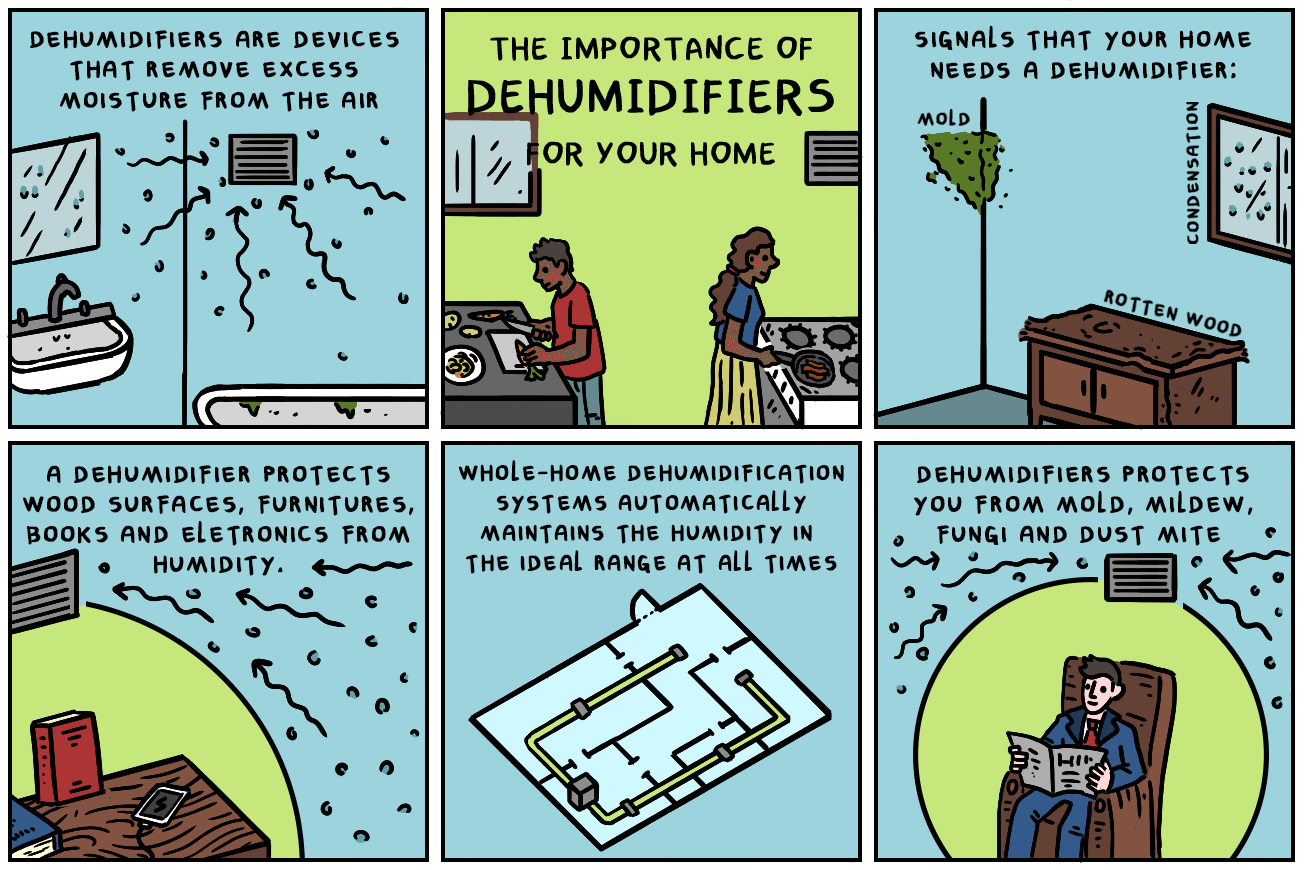Whether or not April showers really do bring May flowers, the spring season certainly ushers in warm and rainy weather. Even across the country’s differing climates and locales, it’s expected that spring brings wet weather, damp conditions and warmer temperatures. The result? Increased humidity.
High humidity levels outdoors mean higher humidity levels indoors too. While you cannot control the humid weather outside, you have a say in your indoor space! For both increased comfort and better health, many homeowners turn to whole-home dehumidifiers during the rainy spring and muggy summer seasons.
Signs Your Home Needs Humidity Control
There are a handful of telltale signs and symptoms of poorly regulated indoor humidity levels. High humidity levels in particular are easy to spot in the home. It might look like:
- Mold or mildew growth on ceilings and walls
- A musty smell or foul odor
- Recurring dampness or noticeable water stains
- Condensation on the inside of windows and doors
- Describing the basement as damp
- Rotting or warping wood furniture, materials and home surfaces
- Simply living in a locale that has recognizable humid months
Home Benefits
Based on the list above, the benefits of regulating indoor humidity in your home should be obvious. A dehumidifier can protect wood surfaces, books, electronics and furniture from damage. Humidity control will also provide a more comfortable living environment overall.
Dehumidifiers can even help lower energy bills. How? In particularly humid areas, the spring and summer weather strains the air conditioning system. Running it more often to keep the home cool is expected, but keeping the home dry is not the AC’s primary purpose. Rather, a dehumidifier removes excess moisture, addressing indoor moisture issues at the root cause. As a result, it takes the pressure off of the AC system, saving both energy and money.
 Humidity Control: Removing humidity isn’t an air conditioner’s primary purpose, but can air conditoners remove excess indoor humidity? We break down the differences. Read more →
Humidity Control: Removing humidity isn’t an air conditioner’s primary purpose, but can air conditoners remove excess indoor humidity? We break down the differences. Read more →Health Benefits
There are many health benefits to proper indoor humidity regulation too. High humidity levels provide the perfect living and breeding ground for harmful indoor biological contaminants. Think pollutants like mold, mildew, fungi and dust mites which rely on moist and damp spaces to survive. These pollutants can also lead to serious health problems or worsening symptoms for allergy and asthma sufferers. A whole-home dehumidifier will help create an inhospitable space for these living organisms and even prevent the future spread of mold and fungi.
What Is a Dehumidifier?
Dehumidifiers are devices that remove excess moisture from the air. Keep in mind that the warmer the air, the more moisture it retains. The appliance pulls in warm moist air using a fan. Inside the device, the air comes into contact with internal coils where it is filtered and cooled. This process converts the excess moisture in the air into condensation and is collected in a reservoir. Then, only drier and healthier indoor air is in circulation.
There are two main reasons homeowners pursue dehumidification solutions. First, the home suffers from noticeably high humidity levels. That kind of humidity can be quite uncomfortable. For anyone that’s experienced a humid summer, sticky skin and instant sweat—you know that high humidity is not a particularly pleasant experience. And it’s certainly not something you want to endure indoors.
Another popular reason to pursue dehumidification is to minimize damp indoor living environments for health reasons. High humidity aids mold and mildew growth, worsens allergies and asthma symptoms and can even create health problems.
Comfort and health factors are common reasons to pursue dehumidifiers—particularly in the spring and summer months. Thankfully, a whole-home dehumidifier addresses both.

When Is Dehumidifier Season?
True humidity feels quite suffocating. Dehumidifiers help improve overall comfort and occupant health by minimizing those soggy, sticky, sweaty indoor conditions. When can you use home dehumidifiers? Dehumidifier season technically is dependent on local climate, but in a broad sense, it’s any time when weather conditions are muggy and humid. Such periods combine high moisture and high heat levels and usually occur during spring, summer and early fall. This is when people most rely on dehumidifiers.
If you live somewhere with noticeable season changes, then dehumidifier season starts the moment the winter thaw begins, marking the shift to the rainy season. Just take one midwest writer’s experience of what she refers to as the “Mildew Wars.”
For those that live in climates or locales with year-round high humidity, dehumidification is actually a useful solution for every season. And for those that fall into neither category, but still struggle with indoor moisture, the culprit could simply be modern building methods that prioritize well-insulated airtight homes. Whatever reason has you prepping the home for a damp seasonal transition or an exceedingly humid summer, whole-home dehumidifiers are a helpful IAQ upgrade.
Choosing a System That Dehumidifies the Entire Home
The best solution to dehumidify your entire living space is a whole-home dehumidifier. These systems install directly into the HVAC system and use existing HVAC ductwork to remove excess moisture from the entire space. Whole-home dehumidifiers also have a long expected system lifespan because they are low-maintenance, in-duct solutions. You can think of them simply as a helpful HVAC system add-on.
An alternative option is to purchase portable dehumidifiers. It’s important to keep in mind that a single-room unit can only remove moisture from the air in a specific area. Unless you live in a studio apartment or only have moisture issues in one room, whole-home systems are likely the better option. Let’s compare the two systems further.
Maintenance
Maintenance is easier with whole-home dehumidifiers. As in, pretty much nonexistent. Once the system is installed, it works in tandem with the HVAC system to provide cleaner, drier indoor air. When the HVAC contractor comes for seasonal system maintenance or a fix, simply have them also check the dehumidifier. Maintenance with portable units however is very important for dehumidifier performance. Specifically, it’s crucial to routinely clean the dehumidifier and routinely empty the water reservoir, or else the health benefits are moot.
What Should the Dehumidifier Be Set To?
The ideal indoor humidity range for health and comfort is between 40 and 60%. Portable units should thus be set somewhere between 40–60%. Whole-home dehumidifiers technically don’t need to be set at all. Rather, they automatically measure indoor humidity levels and properly respond accordingly to maintain the ideal humidity range.
Choosing the Right Size
The right size dehumidifier depends on the indoor space you want to cover. Whole-home dehumidification systems have a larger capacity and can dehumidify more substantial amounts of air at once compared to portable units. After all, they are in-duct systems. Whole-home dehumidifier sizes range from around 1800 sq. ft. to 3500 sq. ft. of coverage while portable units range roughly between 500 sq. ft. to 2000 sq. ft. Portable units have set water capacities as well, ranging from 30 pints to 70 pints compared to whole-home systems which use home pipes to empty automatically.
Cost
The largest drawback to whole-home systems is the initial sticker price compared to portable units which have a cheaper and more appealing upfront cost. Whether or not a portable unit is actually cheaper in the long term depends on why you need a dehumidifier. If you want to dehumidify the entire home, then one in-duct investment is likely better than multiple portable dehumidifiers. But if you want to target a small area, then a whole-home system probably isn’t worth the purchase. Also, make sure to take into account the cost-savings of lower energy bills vs. more energy spent running multiple single-room units.
Upgrading to a Whole-Home Dehumidifier for Springtime
In the end, the best dehumidifier solution for your space will truly depend on desired coverage and specific IAQ issues. Home air quality upgrades often seem expensive and bothersome to pursue. However, we can assure you that whatever reason or purpose initially motivated you to begin researching dehumidification or IAQ solutions are worth the effort. Indoor humidity control and proper moisture regulation have lasting health benefits, home quality improvements, increased comfort and potential utility cost savings. Investing this spring means a healthier home for years to come.



